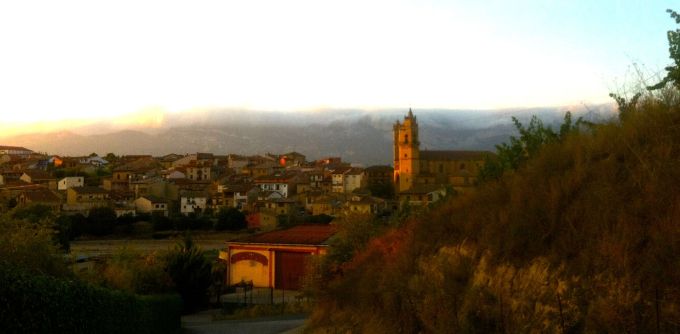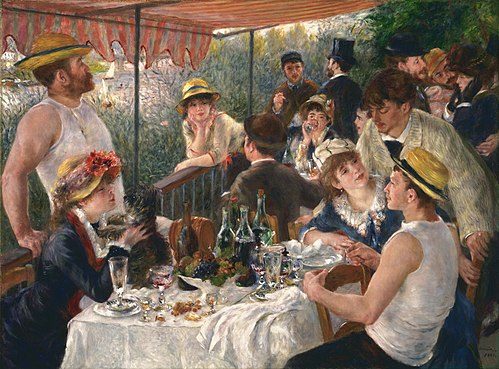Back when the weather was nice and warm, I took two separate trips to visit Spain’s main wine region, La Rioja. For the first trip, I set out from Madrid, along with three other girls and a little dog and stayed at a cute little hotel in tiny, charming Elciego. While it is in the La Rioja region, Elciego is technically part of the Basque Country (an area Spain known for its killer food and whose residents have long supported seceding from the rest of Spain to form their own country). The most notable thing about Elciego is the Hotel Marqués de Riscal, opened in 2006, designed by the architect Frank Gehry. It looks crazily out of place in such a small pueblo, but it is quite a sight with its swoopy swooshy, purple design. One morning I went jogging on a long road through vineyards behind this grandly bizarre hotel and didn’t totally hate running while doing it.


For the second trip, a group of six of us, this time including Mr. Dame in Spain, stopped one night in La Rioja on our way to San Sebastian. San Sebastian was the star of the trip (and subject of a future post) but we enjoyed a good meal and a good night of sleep in a La Rioja “gastrohotel” in the town of Ezcaray and spent the following afternoons sipping wines and loving life.
The highlights:
Bodegas Muga
This family-owned winery in the town of Haro is located in a restored 200-year old building. While I haven’t ever done the tour of the winemaking facilities, I’ve twice done a flight of tastings at the bar. It’s very reasonably priced for sampling five delicious wines (including one sparking wine). The bustling provincial town of Haro is also really cute, so walking from the train tracks (where La Muga is located) up into the center of Haro is highly recommended.
Laguardia and El Fabulista
The Medieval, pedestrian-only walled town of Laguardia is a gem in La Rioja. The town is perched atop a hill, making for panoramic views of the vineyards below and the Sierra de Cantabria mountains off in distance. But the coolest thing about Laguardia, which has a population of about 1,500 people, is that there are 350 caves under the town. In fact, there is more underground portion of Laguardia is greater than the above-ground part of the town. The caves were originally built under houses for defense, but were turned into wine cellars in calmer times. We toured one of the larger of these caves at Bodega El Fabulista., which still makes its wine the traditional way: By putting the grapes in large vats and giving them a good old-fashioned foot-stomping. At least that’s what I understood from the tour, which was almost entirely in Spanish. (They do English tours too, if you book in advance). Most of the tour and the wine tasting itself takes place in the caves, which was was a rather cool and romantic. The wines (all Crianzas) were young and kind of funky. I bought three bottles and they tasted even better at home. I swear I could taste their earthy caveness.
Bodegas Carlos San Pedro Perez de Viñaspre
We were a little tired of official winery tours but still wanted to try more wines in lovely Laguardia when we found a wine shop run by a father and son. This family has been producing wine in La Rioja since 1910. The small shop in downtown Lagaurdia does mostly distribution, but it has a nearby vineyard which grows all the grapes used in the Viñaspre wines and does official tastings. We asked the owner (the son) if we could do a tasting in the shop. He agreed and took us to a storeroom and we crowded in between bottles and boxes and a low-tech labeling machine. Despite the charmless surroundings, the tasting rocked. Most of our group loved the young Crianzas, but I especially liked their reservas. An hour later, we were all fairly tipsy and trying to figure out how to get the cases of wine we’d bought back to our car, which was parked outside the town’s Medieval walls.
The Views at Vivanco Winery
The wines at Vivanco winery in the town of Briones were all good (especially the Tempranillo-Granache rosé and the Dinastia Vivanco Reserva) but the most memorable part of this visit was the stunning design of the winery and the sweeping vineyard/mountain views. Again, our group ditched the tour and bought several wines and enjoyed them outside in the sun
The Tapas Street in Logroño
One of the best dinners I’ve had in Spain to date was in Logroño, the capital of La Rioja, where the famed Calle del Laurel is packed with more than 50 bars, each offering specialty tapas (actually, they call them pinchos outside of Madrid). It’s a crowded and jovial scene of eaters and drinkers poking into bars or ordering through a window and enjoying a caña (a little beer) and a pincho. Popular choices on this street include the embuchado, a Logroño delicacy of flash-fried lambs’ intestines. Obviously I passed on those. One of the first bars we stopped into had at least five vegetarian tapas, which, from my experience, is practically unheard of. I ordered them all and was full 10 minutes into our experience. (But later found a good number of the bars offered vegetarian options). Particularly good were the garlicky-buttery mushrooms on a piece of bread, and a spinach-cheese-nut ball that was creamy, crunchy and rich.
To food. To wine. To life. To La Rioja,
The Dame in Spain





